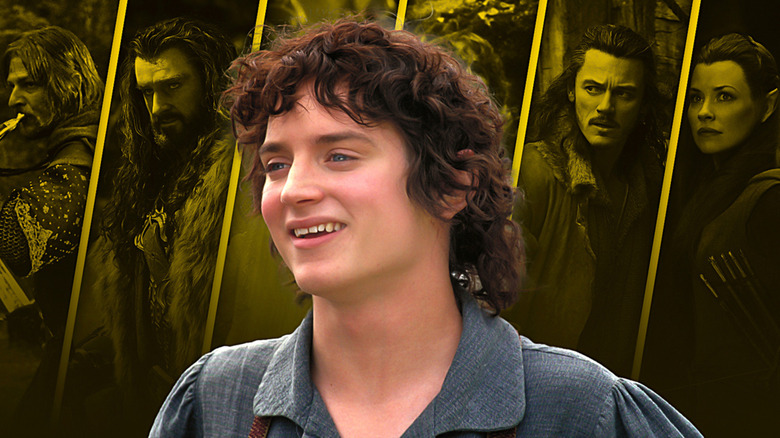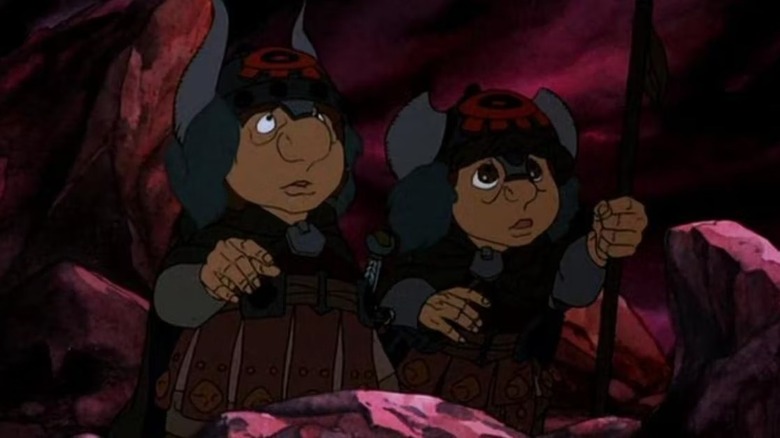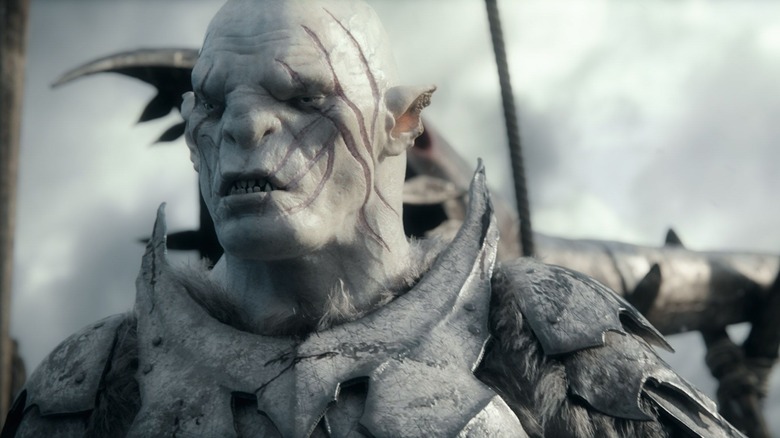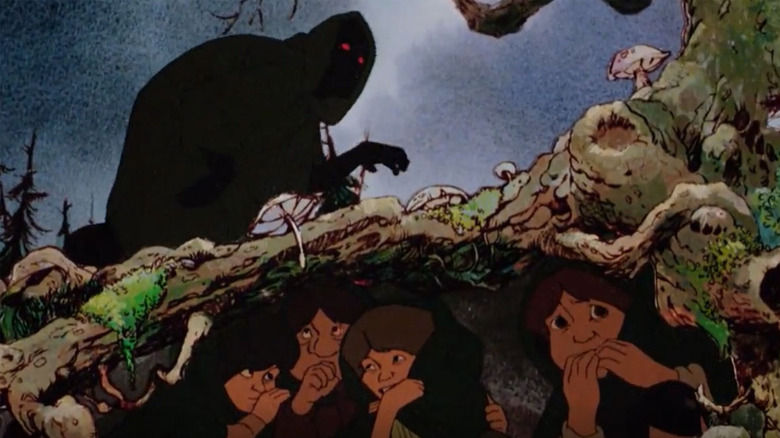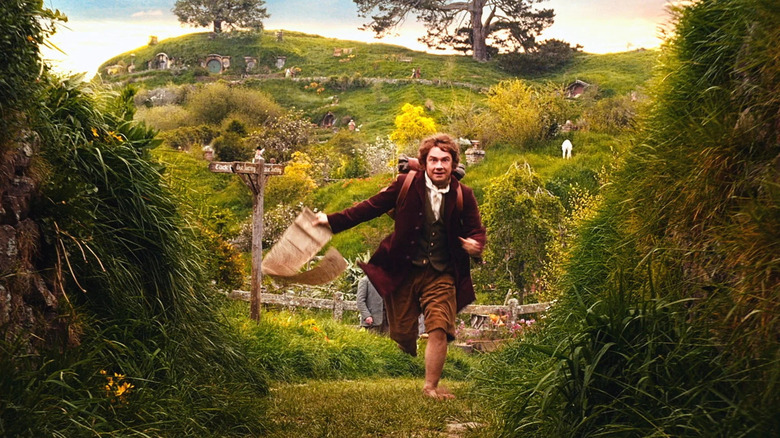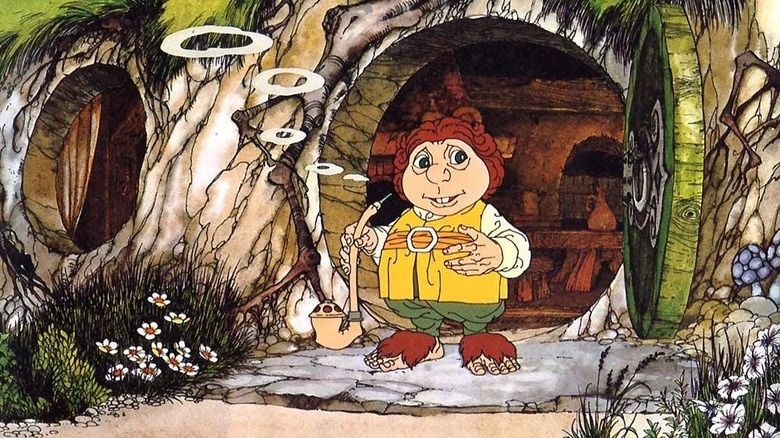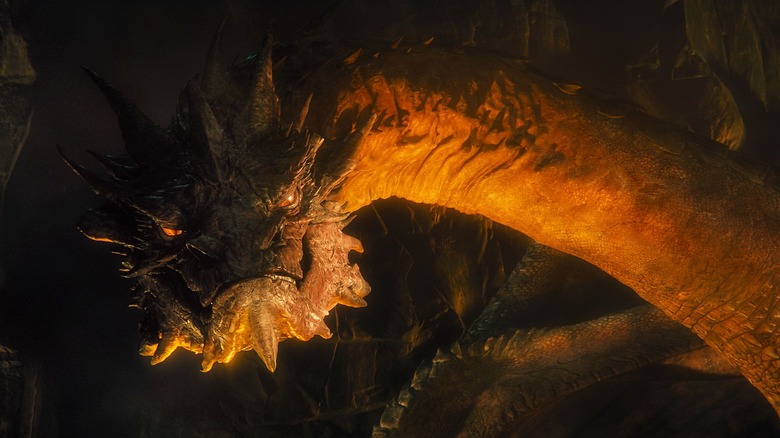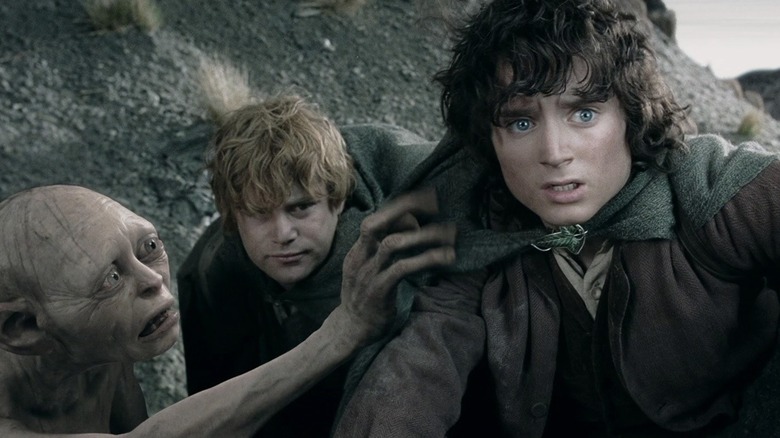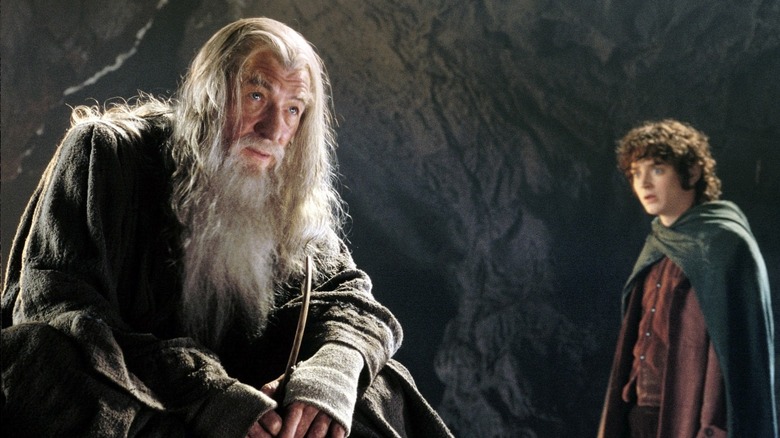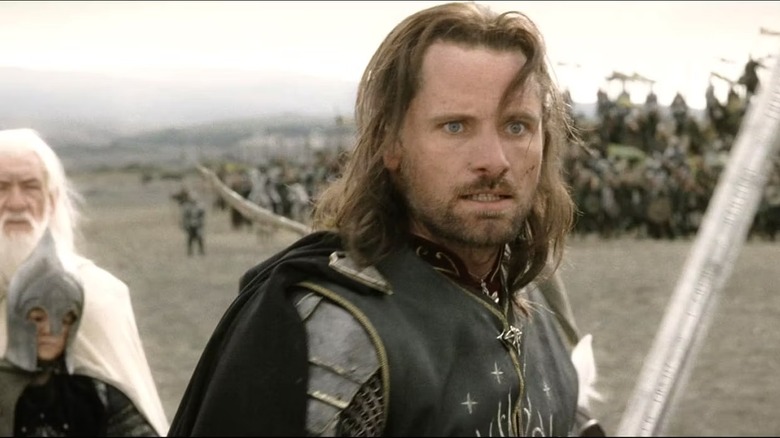Lord Of The Rings And The Hobbit Movies, Ranked
In 1937, J.R.R. Tolkien created the epic fantasy world of Middle-earth for "The Hobbit" and filled it with magical creatures such as dragons, elves, and — of course — hobbits. He followed it up with the 1,137-page saga "The Lord of the Rings," which chronicles the Dark Lord Sauron's threat to take over Middle-earth with the hypnotic power of The One Ring. His son, Christopher Tolkien, took over forty years to put together and posthumously publish "The Silmarillion" and the 12-volume series "The History of Middle-earth," which contain vast accounts of Middle-earth's intricate lore.
Tolkien's ability to develop an enchanted realm with its own mythology, language, and extensive history was the work of a genius. "The Lord of the Rings" and its associated stories are a miracle of fantasy writing and artistry, and their monumental scope made them seem unfilmable. The medium of animation helped director Ralph Bakshi overcome the creative challenges of bringing Middle-earth to life on screen. Then, at the turn of the millennium, New Zealand director Peter Jackson masterfully achieved what no one thought possible by filming "The Lord of the Rings" in live-action, and he later returned to bring "The Hobbit" to life as a trilogy.
Much like the nine rings that Sauron forged, there have been nine film adaptations of Tolkien's works, but only one can rule them all. Here are all the "Lord of the Rings" and "The Hobbit" adaptations, ranked from worst to best.
9. The Return of the King (1980)
In 1980, Rankin/Bass returned for their follow-up to 1977's "The Hobbit," skipping quite a bit of Tolkien's work to jump straight into "The Return of the King." The animation style is a lot more pleasant to look at than the Bakshi version, but the plot arrangement is weak. What makes this version of "The Return of the King" suffer the most is that the filmmakers compress the epic "Lord of the Rings" conclusion into 97 minutes without any context for the first two stories (not every viewer necessarily read the books).
This version of "The Return of the King" uses an awkward framing device where Frodo explains to an elderly Bilbo how he lost a finger, in a feeble attempt to tie this film to the previous one. Since we are jumping straight to the end of Frodo's narrative struggle, the audience is unable to emotionally identify with him. "The Return of the King" is unevenly focused on Frodo and Sam, letting the rest of the characters fall to the wayside or even be omitted entirely, such as Legolas or Gimli. The animation for Eowyn is beautiful, portraying her as a regal beauty with long, flowing golden hair, but there's no sense of triumph when she reveals herself to the Witch-king because she's barely been in the rest of the film.
Although the orcs' song "Where There's a Whip, There's a Way" is a bop, the rest of the soundtrack is terrible: flatly-sung, mundane songs with cringey lyrics that state the obvious of what we see on screen. Overall, the "The Return of the King" has an animated storybook quality that is charming, but the pacing and narrative structure is a nightmare.
8. The Hobbit: The Battle of the Five Armies (2014)
The "Hobbit" series' biggest problem is that director Peter Jackson tries too hard to recapture what made "The Lord of the Rings” trilogy a success. The fast-paced depiction of Thorin's obsession with the Arkenstone feels like a watered-down version of Frodo's anguish over The One Ring. The interracial romance between Tauriel and Kili (which was invented for the movie) is unnecessary and a pale imitation of Arwen and Aragorn's tender romance. Another original character, Alfrid Lickspittle, is too similar to Grima Wormtongue in his vying for control over a peasant town.
The final battle between the orcs, elves, and dwarfs that follows lacks the grandeur or emotional gravity of those in "The Lord of the Rings." It also highlights the greatest sin of this entire trilogy: the godawful CGI. The villain Azog (who is primarily from the Appendices) is completely ruined by the sole reliance on CGI instead of the prosthetics worn by human actors in the first trilogy, which were far more realistic and terrifying. Instead, Azog looks like he belongs in a video game. Also, Thranduil looks really, really silly riding into battle on top of an unconvincing computer-generated moose.
Although every "Hobbit" film was made with a high frame rate of 48fps, the shortcomings of this technique are especially apparent in "The Hobbit: The Battle of the Five Armies," which is the worst of the trilogy. The glossy sheen makes the entire film an eyesore, not at all like the natural aesthetic of Jackson's "Lord of the Rings" trilogy. This final installment in "The Hobbit" series is just pandemonium that's ugly to look at, with circumstances we care little about.
7. The Lord of the Rings (1978)
Ralph Bakshi is a legendary director known for his dark and irreverent animated films such as "Fritz the Cat" and "Cool World." His animated "The Lord of the Rings" adaptation tackles J.R.R. Tolkien's saga up until the end of "The Two Towers." It made extensive use of rotoscoping, a technique where live-action scenes are traced onto animation cels. This device was particularly helpful for the battle scenes, where there had to be a vast amount of orcs or ringwraiths on horses.
The use of rotoscoping is certainly unique and creative, but it also creates quite a surreal viewing appearance where the shadowy drawings flicker, like phantoms seeping into the frame. The blood reds and oranges in the background are unnerving, crafting a dark and frightening world. While there are some beautiful images, such as the starlight of Galadriel's mirror or the sunsets above River Bruinen, there are other visual oddities — such as Aragorn not wearing any pants, or Sam appearing like a bumbling child with missing teeth — that are difficult to overlook.
Ralph Bakshi is a bold filmmaker and some of his shots, such as the scene with the Ringwraith peering over the hobbits under the branch, directly inspired Peter Jackson's later adaptation. While we can admire how Ralph Bakshi rescued "The Lord of the Rings" from being a singular live-action film with limited 1970s technology by using animation, his grim style is not everyone's cup of tea. For many audiences, its roughness zaps the magic and beauty out of Middle-earth. There are certainly dark elements to "The Lord of the Rings," but Bakshi's adaptation is downright dour.
6. The Hobbit: An Unexpected Journey (2012)
Returning to Middle-earth after nearly a decade held so much promise, especially after Peter Jackson was announced as the director. Although Guillermo del Toro, who was originally slated to helm the "The Hobbit," is a stellar fantasy filmmaker, many fans wanted Jackson to return because he had already established an iconic cinematic vision for Middle-earth. Unfortunately, "The Hobbit" movies had a lot of messiness behind the scenes, and Jackson's hiring was so last-minute that it forced him to create sequences on the fly instead of storyboarding them ahead of time. To make matters worse, what was originally a 304-page children's book being stretched into a nearly nine-hour trilogy — like butter scraped over too much bread.
"The Hobbit: An Unexpected Journey" opens with the nostalgic, warm fuzziness of seeing the Shire again, on the day of Bilbo's 111th birthday! Frodo heads into the woods with his book to greet Gandalf! Bilbo complains about the Sackville-Bagginses! "The Hobbit: An Unexpected Journey" is the cheeriest of the trilogy, ending just after defeating the Great Goblin and facing The Lonely Mountain. The clear highlight is the "Riddles in the Dark" sequence, thanks to Martin Freeman's pitch-perfect performance as the persnickety and clever Bilbo, and — as we already know — Andy Serkis' embodiment of the wily Gollum.
One of the more refreshing changes that Jackson makes is not portraying all the dwarfs as elderly, or as gruff, doughy replicas of Gimli; some are young and handsome. Their deep-voiced rendition of the Misty Mountains song is mesmerizing and builds anticipation for the upcoming quest. "The Hobbit: An Unexpected Journey" is the most true to the book and offers the highest rewatch value (minus the absolute ridiculousness of the bird-poop headed, bunny-sledding Radagast).
5. The Hobbit (1977)
The first Middle-earth adaptation was the Rankin/Bass animated television film "The Hobbit" from 1977. Unlike Peter Jackson's live-action adaptation, "The Hobbit" is swift and stays true to the playful tone of Tolkien's original children's book. Running at a brisk 77 minutes, "The Hobbit" does leave out numerous plot elements and characters such as the Arkenstone and Beorn.
The animation is whimsical, warm, and inviting — particularly the portrayal of Bilbo as a cherubic figure with a roly-poly body and big, round eyes. It's exactly the way you'd expect a hobbit to look, especially in a children's storybook. Smaug, however, seems more like a large, furry cat rather than a traditional dragon. The woodland elves are strangely drawn as green-skinned goblins, while Gollum looks like an emaciated frog. The actual goblins are depicted as portly monsters with sharp teeth, sagging skin, and wrinkles. Many of these designs add a creepiness to the imaginative world of "The Hobbit," but still remain fun and childish.
"The Hobbit" also has a memorable soundtrack that evokes Tolkien's love of incorporating songs into his stories. The folk ballad "The Greatest Adventure" by Glenn Yarbrough and the brassy and foreboding "Down, Down to Goblin Town" are highlights that truly capture the spirit of Middle-earth. While you can certainly feel the constraints of having to fit the story in under an hour and a half, "The Hobbit" remains an enchanting lark that has a lot of visual and musical personality. Disregarding the story omissions, it is one of the most faithful and eye-popping portrayals of Tolkien's work.
4. The Hobbit: The Desolation of Smaug (2013)
The entire "Hobbit" series hinges on the reveal of Smaug and the payoff in "The Hobbit: The Desolation of Smaug" is fantastic. In a trilogy where so much of the animation is — sadly — awful-looking, the design of Smaug is incredibly detailed and realistic: his sharp, intricate scales that glow against his piles of gold, his narrow, cat-like eyes, and rows of razor-sharp teeth. Wide shots reveal his astonishing enormity; he fills the frame so completely that the tiny hobbit Bilbo is barely visible next to him.
Actor Benedict Cumberbatch used motion capture to add depth to Smaug's animation. His booming voice (with the aid of some technology) perfectly matches the dragon's giant physicality and arrogance, creating a great foil to Martin Freeman's crafty Bilbo. "The Desolation of Smaug" ends on a rousing cliffhanger where the dwarfs attempt to bury Smaug in molten gold, but he escapes and threatens to destroy Laketown. While this ending certainly leaves audiences on edge, it leaves Smaug's confrontation with Bard to the disappointingly brief opening of "The Battle of the Five Armies." This disjointed pacing indicates that "The Hobbit" trilogy would have benefited either from being a single film or, as originally planned, only being split into two parts.
There are some downsides to "The Hobbit: Desolation of Smaug," mainly in development of the original elf character Tauriel and Gandalf's side quest with — shudder — Radagast, While viewers can appreciate Jackson's attempt to connect "The Hobbit" with "The Lord of the Rings," Gandalf's confrontation with Sauron at Dol Guldur results in strange tonal shifts. "The Hobbit" trilogy would have been better served as a (mostly) lighthearted adventure tale that focused on Bilbo's burglary, rather than making him more of a supporting character in the bloated stories of the other characters.
3. The Lord of the Rings: The Two Towers (2002)
It's difficult to craft a compelling middle part of a trilogy; the filmmakers have to work harder to maintain momentum and keep audiences engaged without the excitement of the beginning and satisfaction of the end. Since the Fellowship is broken, "The Lord of the Rings: Two Towers" deals with multiple storylines and locales, and Peter Jackson interweaves them with finesse.
Tolkien purists take umbrage with some of the movie's changes, particularly the transformation of Faramir from a benevolent leader to an insecure, suspicious man who kidnaps the hobbits and brings them to Osgiliath, hoping to bring The One Ring to his father. But this change adds more dramatic tension to Frodo and Sam's "The Two Towers" narrative, leading to one of the most poignant moments in the trilogy when Sam declares they are fighting for the "good in this world."
One of the greatest aspects of "The Two Towers" is its focus on Andy Serkis' innovative performance as Gollum, the dual-personality, One Ring-obsessed creature. Performing via motion capture, Andy Serkis makes Gollum feel entirely human and challenges the audience's feelings towards him; much like Frodo and Sam, we both pity and distrust him.
All of this builds to Helm's Deep, one of the most epic battle scenes of all time. Peter Jackson crafts the action sequences and harsh realities of war with an electrifying elegance. The use of human actors as the malevolent Uruk-hai gives the war scenes tangible fear. In the pensive preparation scenes, we empathize with the young and elderly peasants of Rohan who are thrust into this stormy showdown. The Helm's Deep scenes are so alive with intense thrills and high emotions, you never want it to end. It's just a taste of the colossal battles to come in the final film.
2. The Lord of the Rings: The Fellowship of the Ring (2001)
Many consider "The Fellowship of the Ring" to be the strongest film in "The Lord of the Rings" live-action trilogy. There is a sense of purity and comfort in this first film found in the idyllic Hobbiton sequence and the unrelenting adventure and excitement before the darker themes of war unfold. For its three hour runtime, Peter Jackson glides between one stunning action set piece to the next with precision and grace. We move from escaping the Ringwraiths to Gandalf's battle against the Balrog to the fearsome confrontation with the Uruk-hai at Amon Hen at an energetic pace.
The opening scenes that take place in the Shire are absolutely breathtaking. It's a sunny haven with rolling green hills where neighbors gather over hearty meals and cold ale, and children frolic amongst the flowers. These sweet and cozy moments make the audience understand why the hobbits cling to their memories of the Shire so dearly throughout their treacherous journey. The majority of "The Fellowship of the Ring," perhaps more than the others in the trilogy, is shot on location in New Zealand. The bubbling rivers, towering mountains, and lush fields as far as the eye can see bring the earthen beauty of Tolkien's fantasy world to magnificent life. You can hardly believe these sights exist on our own Earth.
"The Fellowship of the Ring" marks both the beginning and the end of the Fellowship. The actors' dynamic performances allow the audience to forge a deep bond with each of the nine companions. All of the actors bring such heart and soul to their roles, treating them not just as fantasy characters but everyday people with internal conflicts and complexities. Their lived-in performances create true heroes that we gladly go with to the end, into the very fires of Mordor.
1. The Lord of the Rings: The Return of the King (2003)
"The Lord of the Rings: The Return of the King" is the greatest (and most financially successful) Tolkien film adaptation, largely because of its enormous scale. The way that Peter Jackson seamlessly fuses massive, pulse-pounding battle sequences with uplifting displays of heroism and quiet moments of despair is remarkable, rightfully earning the Academy Award for Best Director, Best Picture, and nine others. Despite the grandeur of the battle sequences, "The Return of the King" remains grounded in the wellspring of genuine human emotions that drew us to Tolkien's story in the first place.
What makes "The Return of the King" such a masterpiece is that it offers an immense cathartic release. After nearly nine hours, we finally reach the peak of the journey to destroy the One Ring and save Middle-earth! All of these climactic sequences give you goosebumps, from Théoden's speech at the Battle of Pelennor Fields to Eowyn destroying the Witch King, and Aragorn leading his small army to what seems like certain death at the Black Gate.
But the Mount Doom sequence is the most spellbinding of all. Howard Shore's gorgeous "Into the West" theme swells our hearts when Sam carries Frodo into the fiery volcano, then rips it out when the idyllic flutes of The Shire softly underscore the hobbits' nostalgic reflections of home. How can you feel anything but a euphoric rush when witnessing our brave heroes finally defeat evil and destroy The One Ring? "The Lord of the Rings: The Return of the King" is the epitome of an unforgettable cinematic experience. Even with the multiple endings that some viewers gripe about, "The Return of the King" is blockbuster moviemaking at its finest.
